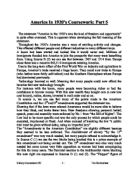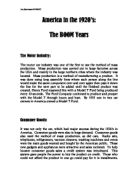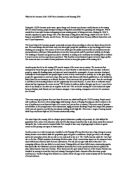“An Extract from Modern World History, by Ben Walsh, published in 1996” is a very useful secondary source which agrees with this statement. He uses the benefits of hindsight to report on the situation seventy years previous, but it has brevity of facts. Though he does mention, “In both Chicago and New York there was a small, but growing Black middle class”. Agreeing with the statement now for the black majority. “There was a successful “ Black capitalist” movement, encouraging blacks to set up in businesses. Furthermore “the popularity of jazz made many Blacks into high-profile media figures and the black neighbourhood of Harlem in New York became a centre of musical creativity.”
Lastly Source D (4) another secondary source agrees, saying “The flapper was the most obvious but by no means the only example of the new American cult of youth.” Meaning that “freedom and opportunity” was now available to the youth, even though many didn’t approve. ““Flapper,” was the name given to fashionable, usually wealthy, young women whose clothes and behaviour seemed deliberately to challenge the older generation.”
In general the above sources gave mixed reliability and coverage of the facts. In my opinion sources A, C (3), and D (4) are fairly reliable, because they are either straight facts or secondary sources. Whereas D (1) and (2) are both primary and less reliable sources, D (1) is only a photograph, but it’s not clear what it’s stating and only covers “flappers appearance”. And D (2) is a letter to a newspaper, almost certainly from a feminist, making it very partial in terms of views cast.
These sources give a very good side for agreeing with the statement but lack in terms of full coverage of the facts. For instance source C (3) only covers the Good points of the “growing Black middle class”. Not the results towards the white population in theses areas or of it occurring anywhere else in America. Source D (2) is similar also with the emphasis on the “benefits of flappers on the advancement of women’s conditions in the world.” Not on the effect on other people, non-feminist women’s rights or opinions.
Though this boom seemed to benefit all, through hindsight we can see it didn’t. For instance the agricultural industry had been doing great after the war. Selling across the world at any price they wanted. When Europe was up and running again, new tariffs were introduced in America to increase spending and slow the amount of unnecessary imports form Europe, imports had added tax. Soon world trading reduced with America.
The arrogance of America soon leads to a collapse in its agricultural industry. Farmers could no longer sell abroad (where most of their customers were based) and could not compete on home soil with the unbeatably low prices that the Canadians could get away with. Meaning many became bust and had to sell up and move on out. This large-scale reduction in farmers meant, amounts of food fell hugely.
The other sources are a mix of primary and secondary sources, which tend to disagree with the statement. This is the case with the 18th amendment of source A, and sources B (1), B (2), B (3), C (1), C (2), D (3), E and F.
The 18th amendment was a mistake and should never have been passed. The prohibition of alcohol was an infringement of the first point “from the Bill of Rights”. This lead to an increase in criminal activity, with people paying gangsters for illegal alcohol. Source E a primary source of “Al Capone speaking in 1929” is another prime example of this violation, “I’m a businessman. I’ve made my money by supplying a popular demand. If I break the law my customers are as guilty as I am” and he was right. These two work together in disagreeing with the statement.
The other sources do also, but with mixed levels of conviction. For instance in B (1) Vanzetti’s statement sums up the prejudice received by immigrants. “I am suffering because I am a radical and indeed am a radical. I have suffered because I was an Italian, and indeed I am an Italian.”
Source B (2) shows “the impact of the Quota Laws on Immigration”, for “Immigrants from north and west Europe” and those from “South and East Europe.” The number of Immigrants rose initially, for “immigrants from north and west Europe” for the Quota in 1921 then slowly fell for the next two. On the complete opposite between 1907 and 1914 there were nearly 4 times as many “Immigrants from other countries, principally south and east Europe” as there were “from north and west Europe” entering America. This number was cut four times by the “Quota under Act of 1921” and then cut seven more times by the “Quota under National Origins Act 1924” till in 1929 there were just 20,251 “Immigrants from other countries, principally south and east Europe” to every 132,323 “Immigrants from north and west Europe”. A massive change round of figures, from nearly four times as many “Immigrants from other countries, principally south and east Europe” which was heavily influenced by the prejudice and hostility towards immigrants and foreigners present in America.
Source B (3) “a speech made in 1924 by Senator Albert Johnston of Washington State” is another primary source which is only semi-reliable due to its very partial views. “The foreign-born flood is a threat to the happiness of individual Americans,” Is just one example of the very emotive language being used, plus only “Senator Albert Johnston’s” views are expressed, not the full coverage which is required.
Also Sources C (1) and (2) both disagree with the statement. C (1) has no data as to where it is from and only states the facts “They were dragged from the local jail by a crowd of 5,000 townsfolk and hanged.” So is not totally reliable in its facts and though an impartial view seems to be cast it is not definite of its facts and does not use any quotes. C (2) is another partial primary view “from a Chicago Property Owner’s Journal 1920” and is not the best source to rely on for true facts. The coverage of this negative side is also limited, only basing itself on the small groups personal views.
Source D (3) is “from an article by Samuel Byrne, editor of the “Observer” in Pittsburgh, June 1922,” another primary source, and again is mainly partial in its views towards the plunge in feminine decency “there has been a change for the worse during the past year in feminine dress, dancing, manners and general moral standards.” He focuses throughout on the bad side and downfall in stature and standards of women over the past, never mentioning the other side of the story.
Lastly source F the only secondary source which disagrees with the statement is an “Extract from the Twentieth Century World by John Martell, published in the 1980’s”. This view develops around the whole story of “strong prejudice against minority nationalists and new ideas”, “felt by Blacks, Jews, Roman Catholics, poorer immigrants and those who supported political innovations of the left, such as Socialism, trade unionism and Communism.” Though this is a source, which is based on the suffering of immigrants, etc. It is an impartial source throughout and though in little detail, it does cover both sides of the story. It is the only source for disagreeing with the statement that is truly trustworthy for its facts. The others are all partial in one way or another.
Overall I do not agree with the statement “America in 1920’s was the land of freedom and opportunity.”
I do feel that the sources that do agree benefited the whole country of America in one-way or another. Technological advances, the boom in industry and increasing spending was a good foothold for the future but it was largely based on the borrowing of money, shares and agriculture, which was rapidly worsening.
On the contrary the sources that disagree with the statement, largely outnumber the agreeing ones, which largely backs up my opinion. The discrimination against blacks, Jews, Immigrants etc, that was taking place all across America does not in any way constitute towards the statement in question.
Looking back again the disagreeing sources largely outweigh the agreeing ones and from my own knowledge of the persecution that took place and the terrific Wall Street Crash and the Great Depression that followed, primarily based on the large scale borrowing of money towards the new technology and better standards of living. I feel this statement is false and America did not live up to this expectation after the initial few years.
Word Count (excluding quotes) :







